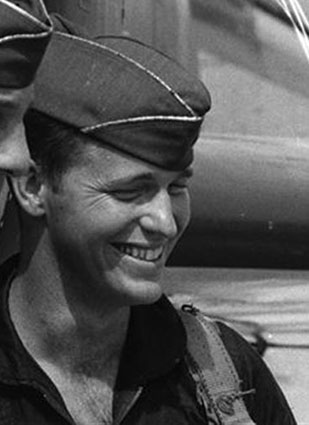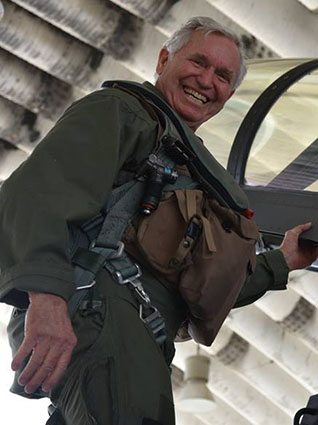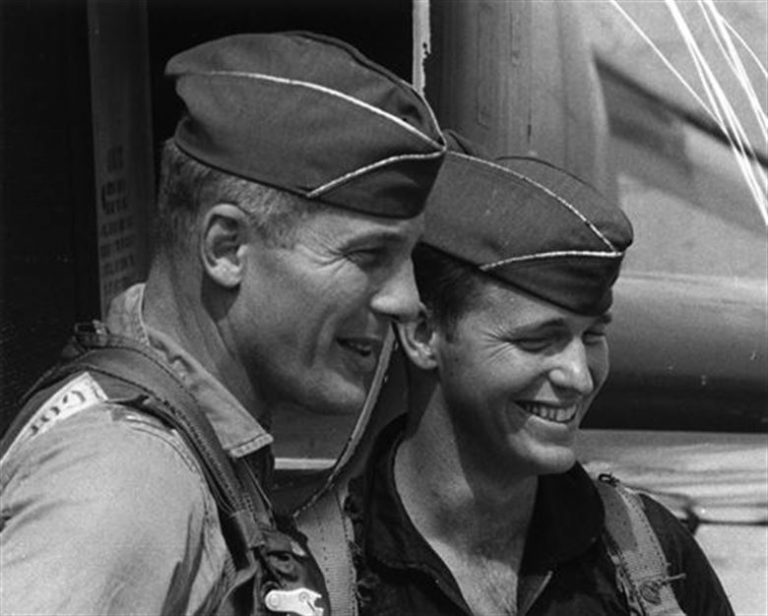“It is said that by downing a MiG in Operation Bolo, JB Stone “..had just changed the course of the air war over North Vietnam” (1).
“The goal of “Operation Bolo” was relatively simple: Make the agile Phantom II look like the cumbersome bomb-laden F-105 and lure the MiGs into a sustained dogfight that depleted the MiG-21s of their relatively small fuel load and flight time. Col. Robin Olds, 8th Tactical Fighter Wing (TFW) commander, and the wing’s tactics officer, Capt. John “J.B.” Stone, devised a masterful plan to lure and trap North Vietnamese MiG-21s by mimicking an F-105 bombing formation.” (2)
“Colonel Robin Olds the Commander of the 8th Tactical Fighter Wing assigned the planning to Capt. John B. Stone, 1st Lt. Joseph Hicks, 1st Lt. Ralph F. Wetterhahn, and Maj. James D. Covington.
The planners determined that if the MiGs reacted, their fuel endurance from takeoff to landing would extend to a maximum of 55 minutes. Arrival times of the F-4 flights over the targeted airfields were set five minutes apart to ensure continuous coverage and maximum opportunities for engagement in the target area, and to attempt to run surviving MiGs out of fuel by preventing them from landing. The mission was also planned so that no other US aircraft would be present, allowing the first three flights of F-4s “missile-free” engagement without having to first identify the target as required by Seventh Air Force rules of engagement.[9][10]
Everything hinged on getting the MiGs airborne; if they didn’t take the bait, then the plan would not come to fruition. In order to deceive the North Vietnamese, the west force had to fly the same ingress routes, altitudes, and speeds as the F-105, use the same air refueling tanker tracks and altitudes, and use F-105 jargon in voice communications. (However, to Olds’s dismay, the flights were still assigned callsigns of MiGCAPs throughout the war, which were the names of American-made automobiles: Olds, Ford, Rambler, Lincoln, Tempest, Plymouth, and Vespa.)[10]
Captain John B. Stone, the wing tactics officer and one of the architects of Operation Bolo, lead the “Rambler” flight, the third into the area. When Rambler entered the engagement, Stone spotted a pair of MiGs popping up through a break in the clouds, dove and launched an AIM-7 Sparrow, which failed to ignite. Stone fired again a second Sparrow that successfully guided to one of the MiGs. Observing a third MiG behind him, he coordinated his maneuvers with his wingman and steered the MiG into the line of fire of Major Philip P. Combies (Rambler 04). He saw the battle in this way:
We flew at 13,440 feet (4,800 meters) above sea level and our speed was 540 knots. A little bit after completing a turn to the northwest, we identified a patrol of four MiG-21s in spread formation at a distance of 5 miles –about 8 km- at ‘2 o’clock’ and below us. Two more MiGs appeared 2 miles –about 3 km – behind. . . . When the MiGs crossed in front of Stone, he started to follow, breaking left and losing height. Due to that, the flight spread wide to the right, and I found myself higher and somewhat to the right of the others. I kept the throttle to the minimum during the first phase of the combat. So, when the MiGs broke to the left, and the engagement began. I chose one of the MiGs and followed him with my radar. I don’t think that we ever exceeded 4G’s during the whole engagement. I decided to follow the Navy pilots’ tactics – at close range foregoing the radar tracking, but looking through the reticle instead. When I realized that I was in the right position, I pushed the fire button, released it, pushed it again, and waited. I did not even see the first Sparrow. However, I followed the entire trajectory of the second one, from launch to impact. I fired the missiles at less than 2,000 yards from the MiG’s tail, at a height of 9,800 feet (3,500 meters) while turning to the left. The second one hit the tail section of the enemy aircraft. A second later, I saw a huge, orange ball of fire.
Seconds later, another MiG-21 crossed in front of Rambler 02 and was apparently destroyed by a Sparrow fired by its pilot, Lawrence Glynn. The MiG, hit behind the tailfin, exploded in a fireball. This, the third MiG-21 downed by Rambler flight, raised the final score of the day to 7:0 in favor of the F-4s. SA-2 missile launches (five in all) began to threaten Rambler flight, which also disengaged. The entire combat lasted twelve minutes.”
“The final four flights of 8th TFW aircraft arrived to find the engagement over and departed the area because of the SAM threat, while the Da Nang-based East Force assessed the weather conditions and did not penetrate North Vietnamese airspace. Two of the Ubon-based West Force had aborted the mission for maintenance problems, and ultimately only 26 of the 56 assigned fighters entered the target area, and only 12 of those engaged.” (2)
Source: (1) from http://smokejumpers.com/index.php/smokejumpermagazine/getitem/articles_id=377, (2) https://www.nationalmuseum.af.mil/Visit/Museum-Exhibits/Fact-Sheets/Display/Article/196006/operation-bolo/, remainer of the article excerpted from Wikipedia https://en.wikipedia.org/wiki/Operation_Bolo)



